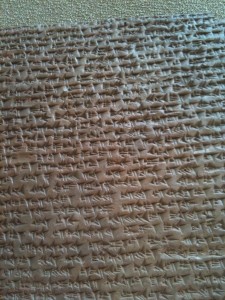Scholars argue about which came first, Egyptian hieroglyphics or Sumerian cuneiform, but neither side has convinced me. Given that they developed within 100 years (in about 3200 BC) and 1000 kilometers of each other, it’s pretty certain that one led to the other.
The Sumerians lived in present-day Iraq. For their writing, they made little pads of clay, about the size of a modern smartphone, and pressed designs into them. You might have thought that they would scratch symbols into the clay, but they seemed big on pressing things into the clay. This might have to do with an old tradition of pressing tokens into clay.
At first the Sumerians did draw recognizable pictures (e.g. of people, sheep, etc.), but those became stylized and simplified over time.
Standardized, however, not so much. Being brand-new, they didn’t have rules or traditions telling them how they could or could not write. It was also used over thousands and thousands of years, so it isn’t really accurate to talk about “the” Sumerian cuneiform unless you talk about it at a very specific time (like when the Akkadians conquered the Sumerians).
At first, they used sticks to press shapes into the clay, but then moved to using reeds — basically swamp grass with a wedge-shaped cross-section — instead. The Sumerians appeared to hold the reeds vertically and press the ends into the clay, lift up, rotate and/or move, press down, repeat. Note that the reeds were tiny — cuneiform characters are more like 6 pt Latin font than 12 pt font.
Scripts that used cuneiform technology (i.e. wedge-shaped impressions in clay) were used for a long, long time, at least until 75 AD.
Links: Ancient Scripts, Wikipedia





Pingback: Akkadian cuneiform | Glyph of the Day
Pingback: Chinese — Oracle bones | Glyph of the Day
Pingback: Indus script — 2600 BC, Pakistan | Glyph of the Day
Pingback: Epi-Olmec — Mexico, 900BC? ~450 BC? | Glyph of the Day
Pingback: Elamite cuneiform — 2200 BC, Iran | Glyph of the Day
Pingback: Hittite — 1700 BC?, Turkey | Glyph of the Day
Pingback: Egyptian hieroglyphics — 3200 BC, Egypt | Glyph of the Day
Pingback: Cherokee — 1819, USA | Glyph of the Day